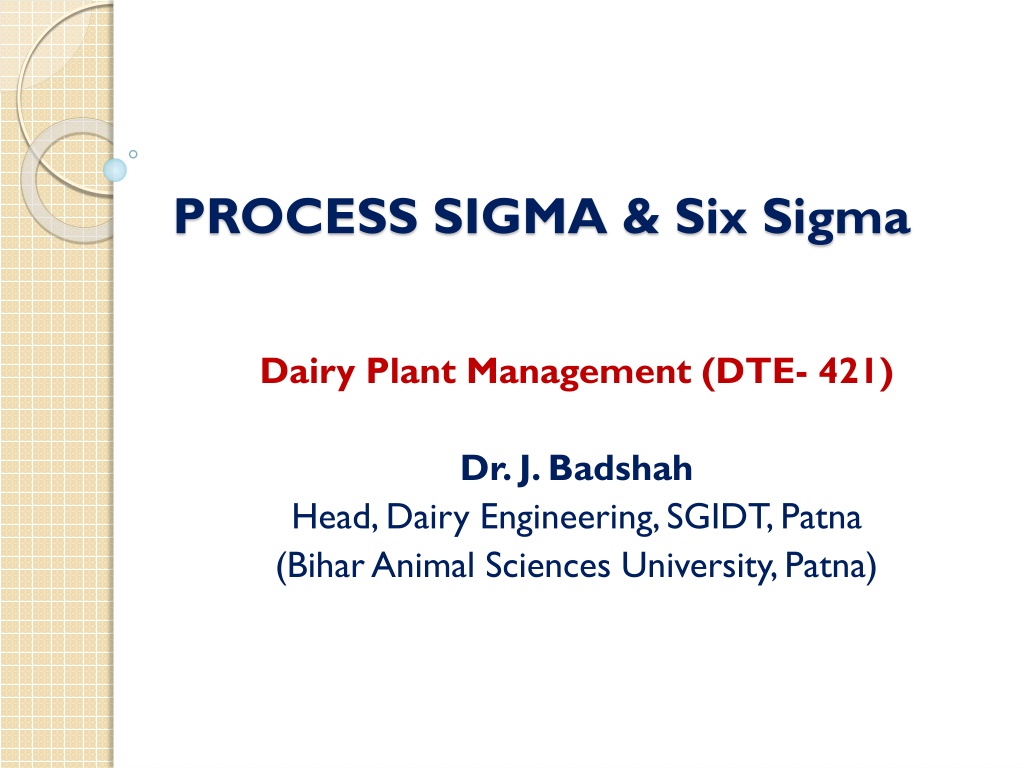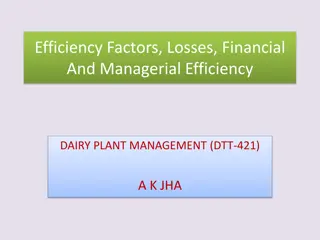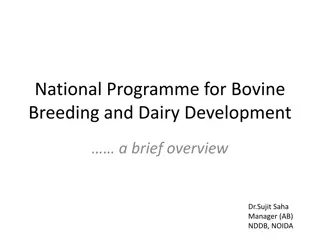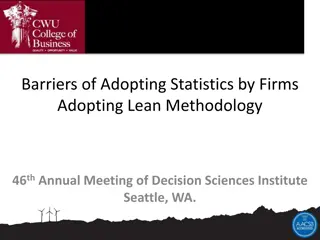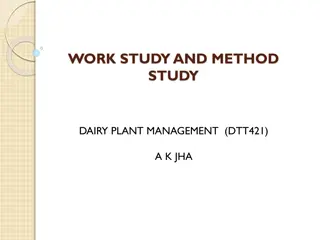Understanding Process Sigma and Six Sigma in Dairy Plant Management
Process Sigma and Six Sigma are key measures of process capability in Dairy Plant Management, indicating the level of defects and quality. CTQ features help in maintaining critical quality aspects to meet customer expectations. Learn how to calculate process Sigma and Sigma level in the context of a power company.
Download Presentation

Please find below an Image/Link to download the presentation.
The content on the website is provided AS IS for your information and personal use only. It may not be sold, licensed, or shared on other websites without obtaining consent from the author. Download presentation by click this link. If you encounter any issues during the download, it is possible that the publisher has removed the file from their server.
E N D
Presentation Transcript
PROCESS SIGMA & Six Sigma Dairy Plant Management (DTE- 421) Dr. J. Badshah Head, Dairy Engineering, SGIDT, Patna (Bihar Animal Sciences University, Patna)
PROCESS SIGMA OR SIGMA LEVEL Process sigma (also referred to as sigma level) is a measure of process capability. The higher the process sigma, the more capable the process is. A Six Sigma process has a short-term process sigma of 6, and a long-term process sigma of 4.5. The theoretical defect rate for a Six Sigma process is 3.4 defects per million (DPM). In simple term, the process sigma indicates how many standard deviations ( Sigmas ) can fit inside the gap between the process average and the nearest specification limit.
Process Sigma Level Calculation Note that the above example shows a histogram for a particular CTQ, so the process sigma of 4.5 applies to the specific CTQ being studied.
CTC (Critical to Quality) Features A CTQ is a Critical to Quality product feature that must be maintained in order to meet customer expectations in deciding Sigma level. CTQ s are useful in helping product designers and manufacturing teams know where to focus their efforts in designing robust products and processes. The Engineering drawing of each component of a structure must be maintained to optimum level of CTC features. It should consider the design and manufacturing facilities as well as input resources cost along with the market value of products.
How to Calculate Process Sigma Consider a power company for illustration purposes: A power company measures their performance in uptime of available power to their grid. Here is the five-step process to calculate your process sigma. Step 1:DefineYour Opportunities An opportunity is the lowest defect noticeable by a customer. This definition, of course, is debatable within the Six Sigma community. Here s a useful snippet from the forum discussing this point: Typically, most products (and services) have more than one opportunity of going wrong. For example, it is estimated than in electronics assembly a diode could have the following opportunities for error: 1) wrong diode and 2) wrong polarity (inserted backwards), so for each assembly shipped, at least two defect opportunities could be assigned for each diode. Apparently, some manufacturers of large complex equipment with many components prefer to count two opportunities in this case.
How to calculate Sigma Level Step 2: Define Your Defects Defining what a defect is to your customer is not easy either. You need to first communicate with your customer through focus groups, surveys, or other voice of the customer tools. Returning to our power company example, a defect is defined by the customer as one minute of no power. An additional defect would be noticed for every minute that elapsed where the customer didn t have power available. Step 3:MeasureYour Opportunities and Defects Now that you have clear definitions of what an opportunity and defect are, you can measure them. The power company example is relatively straight forward,but sometimes you may need to set up a formal data collection plan and organize the process of data collection. Step 4:CalculateYourYield The process yield is calculated by subtracting the total number of defects from the total number of opportunities, dividing by the total number of opportunities,and finally multiplying the result by 100.
How to calculate Sigma Level Step 5:Look Up Process Sigma The final step (if not using the iSixSigma Process Sigma Calculator) is to look up your sigma on a sigma conversion table, using your process yield calculated in Step 4. Assumptions No analysis would be complete without properly noting the assumptions made. In the above table, we have assumed that the standard sigma shift of 1.5 is appropriate (the process sigma calculator allows you to specify another value), the data is normally distributed, and the process is stable. In addition, the calculations are made with using one-tail values of the normal distribution.
Calculation of Six sigma level DPMO and Process Sigma (Sigma Level): Scenario A laboratory reports 1000 ED stat results in a month (Product). 10% or 100 results are not reported out within the specified period of time (Defects). The number of Opportunities for defects is 3, representing the three phases of testing (preanalytical, analytical, and post-analytical phases). Once the number of products, defects, and opportunities are known, both DPMO and Sigma level can be calculated. Defects per opportunity (DPO)= Defect/(Product x Opportunities). Using the data presented in the scenario, DPO= 100/(1000 X 3) or 0.033333 Defects per million opportunities (DPMO) Six-Sigma is determined by evaluating the DPMO, Multiply the DPO by one million. DPMO= 0.33333 X 106or 33,333 Process Sigma Once you have determined the DPMO, you can now use a Six Sigma table to find the process sigma. You will look for the number closest to 33,333 under defects per 1,000,000. In this case, the process sigma is ~ 3.3.
Six Sigma Six Sigma stands for Six Standard Deviations (Sigma is the Greek letter used to represent standard deviation in statistics) from mean. Six Sigma methodology provides the techniques and tools to improve the capability and reduce the defects in any process. A process with Six Sigma capability means having 12 standard deviations of process output between the upper & lower specification limits. Essentially, process variation is reduced so that no more than 3.4 parts per million fall outside of the specifications limits. The higher the sigma number,the better.
Six Sigma Six Sigma is a systematical process of quality improvement through the disciplined data-analyzing approach, and by improving the organizational process by eliminating the defects or the obstacles which prevents the perfection . organizations to reach the Six sigma points out the total number of the defects that has come across in an organizational performance. Any type of defects, apart from the customer specification, is considered as the defect, according to Six Sigma. With the help of the statistical representation of the Six Sigma,it is easy to find out how a process is performing on quantitatively aspects. A Defect according to Six Sigma is nonconformity of the product or the service of an organization.
Six Sigma Since the fundamental aim of the Six Sigma is the application of the improvement on the specified process, through a measurement-based strategy, Six Sigma is considered as a registered service mark or the trade mark. Six Sigma has its own rules and methodologies to be applied. In order to achieve this service mark, the process should not produce defects more than 3.4. These numbers of defects are considered as the rate of the defects in a process should not exceed beyond the rate 3.4 per million opportunities .
